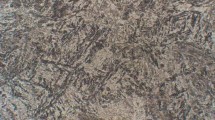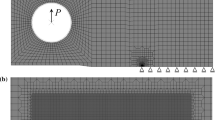Abstract
The formation of a subgrain structure by the passage of a fatigue crack in low-carbon steel has been detected by backscattered electron imaging in the SEM. The distribution of subgrain sizes has been measured as a function of cyclic stress intensity and environment, and from this data the cyclic stress and strain range distributions have been determined, as has the energy dissipated during propagation of the fatigue crack. These results are compared to theoretical and other experimental findings. The energy equivalent (per unit area of incremental crack advance) of the environment is found to be 106 times the surface energy of iron. In an inert environment, the maximum cyclic stress range developed at the crack tip is found to be approximately 2.3 times the yield stress, independent of cyclic stress intensity. Water vapor effectively lowers this stress range, and causes it to assume a dependence upon cyclic stress intensity.
Résumé
En faisant apparaître les électrons rétrodispersés lors de l'analyse scanning-microscope, on a détecté la formation d'une structure de sous-grain lors du passage d'une fissure de fatigue dans un acier à bas carbone. La distribution des tailles de sous-grain a été mesurée en fonction de l'intensité de contraînte cyclique et de l'environnement et à partir de ces données on a déterminé la contrainte cyclique et la distribution des amplitudes de déformation ainsi que l'énrgie dissipée lors de la propagation d'une fissure de fatigue. Ces résultats ont été comparés avec des données théoriques et expérimentales en provenance d'autres sources. L'énergie équivalente par unité de surface de croissance unitaire de la fissure correspondant à un environnement déterminé a été trouvée être 106 fois l'énergie de surface du fer. Dans un environnement inerte, l'amplitude de contrainte cyclique maximum développée à l'extrémité d'une fissure se trouve être approximativement 2, 3 fois la limite élastique et ce indépendamment de l'intensité de la contrainte cyclique. La vapeur d'eau affecte de manière effective cette amplitude de contrainte et conduit à supposer une dépendance sur l'intensité de contrainte cyclique.
Similar content being viewed by others
References
J.C. Grosskreutz and H. Mughrabi in Constitutive Equations in Plasticity, MIT Press, Cambridge, Mass. (1975) 251–326.
F.V. Lawrence and R.C. Jones, Metallurgical Transactions A, 1 (1970) 367–376.
D.C. Joy and D.E. Pease, “SEM Study of Dislocation Subcells in Deformed Copper and Stainless Steel,” Unpublished Research (1974) Dr. Joy is at Bell Labs, Murray Hill, NJ.
D.L. Davidson, J. Lankford, T. Yokobori, and K. Sato, International Journal of Fracture, 12 (1976) 379–385.
T. Yokobori, K. Sato, and Y. Yamagushi, Reports of the Research Institute of Fracture Mat., 6 (1970) 49–67.
D.L. Davidson and J. Lankford, Fracture 1977, 2, U. of Waterloo Press, Waterloo, Ont. (1977) 897–904.
J. Awatani, K. Katagiri and H. Nakai, Metallurgical Transactions A, 9A (1978) 111–116.
O.K.Chopra and C.V.B. Gowda, “Substructural Development During Strain Cycling in Alpha Iron”, Univ. of Waterloo Civil Engineering Dept. Report, Waterloo, Ont. (1974).
H.F. Wachob, “The Effect of Strain Rate and Depressed Temperature on the Low Cycle Fatigue Behaviour of Alpha Iron,” Cornell University Ph.D. Dis., Ithaca NY (1976).
D.L. Davidson and J. Lankford in Environment Sensitive Fracture of Engineering Materials, AIME, New York (1979) 581–594.
J. Schijve, “Analysis of the Fatigue Phenomenon in Aluminum Alloys”, Delft Univ. Ph.D. Dis., Appendix B, Delft Univ. of Tech., Delft, The Netherlands (1964).
K. Katagiri, J. Awatani, A. Omura, K. Kuyangi and T. Shiraishi, Fatigue Mechanisms, ASTM STP 675 ASTM, Philadelphia (1979).
R.W. Landgraf in Work Hardening in Tension and Fatigue, AIME, New York (1977) 240–259.
J.R. Rice and G.F. Rosengren, Journal of Mechanics and Physics of Solids, 16 (1968) 1–12.
N. Levy, P.V. Marcal, W.J. Ostergren and J.R. Rice, International Journal of Fracture Mechanics, 7 (1971) 143–156.
D.M. Tracey, Journal of Materials Technology, 98 (1976) 146–151.
D.L. Davidson, SEM/1979, 2 79–86.
D.R. Williams, D.L. Davidson and J. Lankford, Experimental Mechanics, 20 (1980) 134–139.
D.L. Davidson and A. Nagy, Journal of PhysicsE, 11 (1978) 207–216.
P.K. Liaw, M.E. Fine and D.L. Davidson, Fatigue of Engineering Materials and Structures, 1980 (in press).
J. Kikukawa, J. Jono and M. Adachi, Fatigue Mechanisms, ASTM STP 675, ASTM, Philadelphia (1979) 234–253.
G.W. Simmons, P.S. Pao and R.P. Wei, Metallurgical Transactions A, 9A (1978) 1147–1158.
D.J. Dwyer, G.W. Simmons and R.P. Wei, Surface Science, 64 (1977) 617–632.
H. Mughrabi, K. Herz and X. Stark, Acta Metallurgica, 24 (1976) 659–669.
H. Abdel-Raouf, P. H. Benham and A. Plumbtree, Con. Met. Quarterly, 10 (1971) 87–94.
H. Abdel-Raouf, A. Plumbtree and T.H. Topper, ASTM STP 519, ASTM, Philadelphia (1973) 28–57.
K. Herz, H. Mughrabi and M. Wilkens, Arbeitsbericht MPI/77/P3, Max Planck-Institut fur Metallforschung, Stuttgart, Germany (1977).
Author information
Authors and Affiliations
Rights and permissions
About this article
Cite this article
Davidson, D.L., Lankford, J. The effect of water vapor on fatigue crack tip stress and strain range distribution and the energy required for crack propagation in low-carbon steel. Int J Fract 17, 257–275 (1981). https://doi.org/10.1007/BF00034501
Received:
Issue Date:
DOI: https://doi.org/10.1007/BF00034501




